ICT Project Management 2017 Assignment on Project Lifecycle Completion
VerifiedAdded on 2019/11/20
|14
|2841
|235
Project
AI Summary
This project management assignment analyzes the lifecycle of a successfully completed ICT project. It begins with a project charter outlining the project name, team members, roles, responsibilities, and a communication plan. The assignment delves into team dynamics, including positive and negative aspects of teamwork, team values, and a code of ethics. It also includes a learning cycle analysis and a reflection on the project's key elements. The communication plan is detailed, specifying communication mediums and frequencies for different stakeholders. Furthermore, the assignment highlights the importance of leadership and ethical considerations in project management, providing valuable insights into the practical aspects of managing ICT projects. The project also includes a reflection on the roles of project team members and the importance of knowledge sharing, emphasizing the significance of clear communication, well-defined roles, and ethical practices for project success. The assignment concludes with a comprehensive reflection on the project's key aspects and a discussion of the role of leadership.
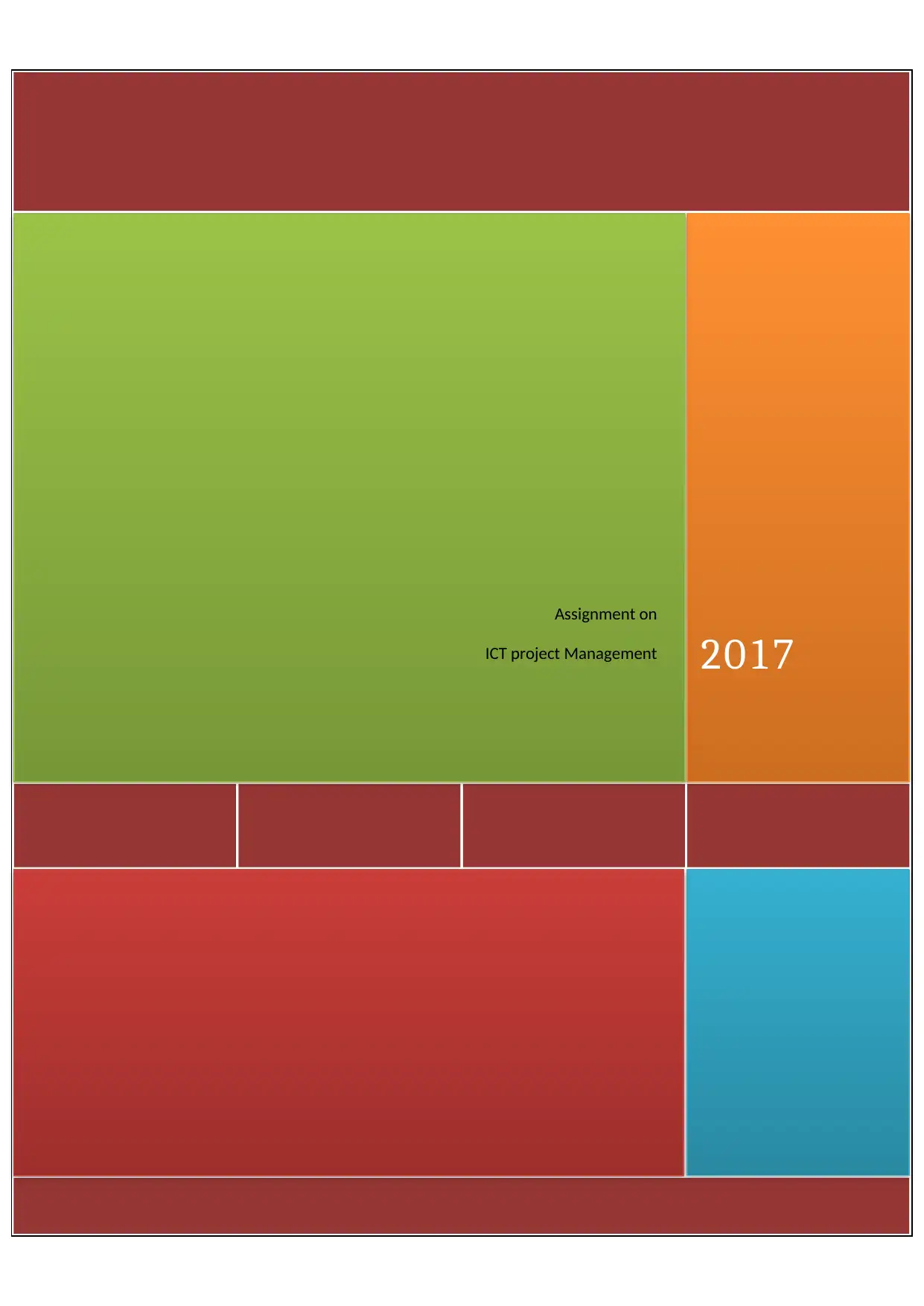
Assignment on
ICT project Management 2017
ICT project Management 2017
Paraphrase This Document
Need a fresh take? Get an instant paraphrase of this document with our AI Paraphraser

Project Management
Contents
Part 1: Project charter............................................................................................................................2
Project name:.....................................................................................................................................2
Project team:......................................................................................................................................2
Overview of the project:....................................................................................................................2
Team description:..............................................................................................................................3
Roles and responsibilities:.................................................................................................................3
Team communication plan:...............................................................................................................4
Positive and negative aspect:.............................................................................................................5
Team values:......................................................................................................................................6
Code of ethics:...................................................................................................................................7
Rules and expectation:.......................................................................................................................7
Signature:..........................................................................................................................................8
Part Two:...............................................................................................................................................8
Learning cycles:.................................................................................................................................8
Reflection:.........................................................................................................................................9
Part three: Communication plan............................................................................................................9
Part four: Reflection............................................................................................................................11
References:..........................................................................................................................................12
1
Contents
Part 1: Project charter............................................................................................................................2
Project name:.....................................................................................................................................2
Project team:......................................................................................................................................2
Overview of the project:....................................................................................................................2
Team description:..............................................................................................................................3
Roles and responsibilities:.................................................................................................................3
Team communication plan:...............................................................................................................4
Positive and negative aspect:.............................................................................................................5
Team values:......................................................................................................................................6
Code of ethics:...................................................................................................................................7
Rules and expectation:.......................................................................................................................7
Signature:..........................................................................................................................................8
Part Two:...............................................................................................................................................8
Learning cycles:.................................................................................................................................8
Reflection:.........................................................................................................................................9
Part three: Communication plan............................................................................................................9
Part four: Reflection............................................................................................................................11
References:..........................................................................................................................................12
1
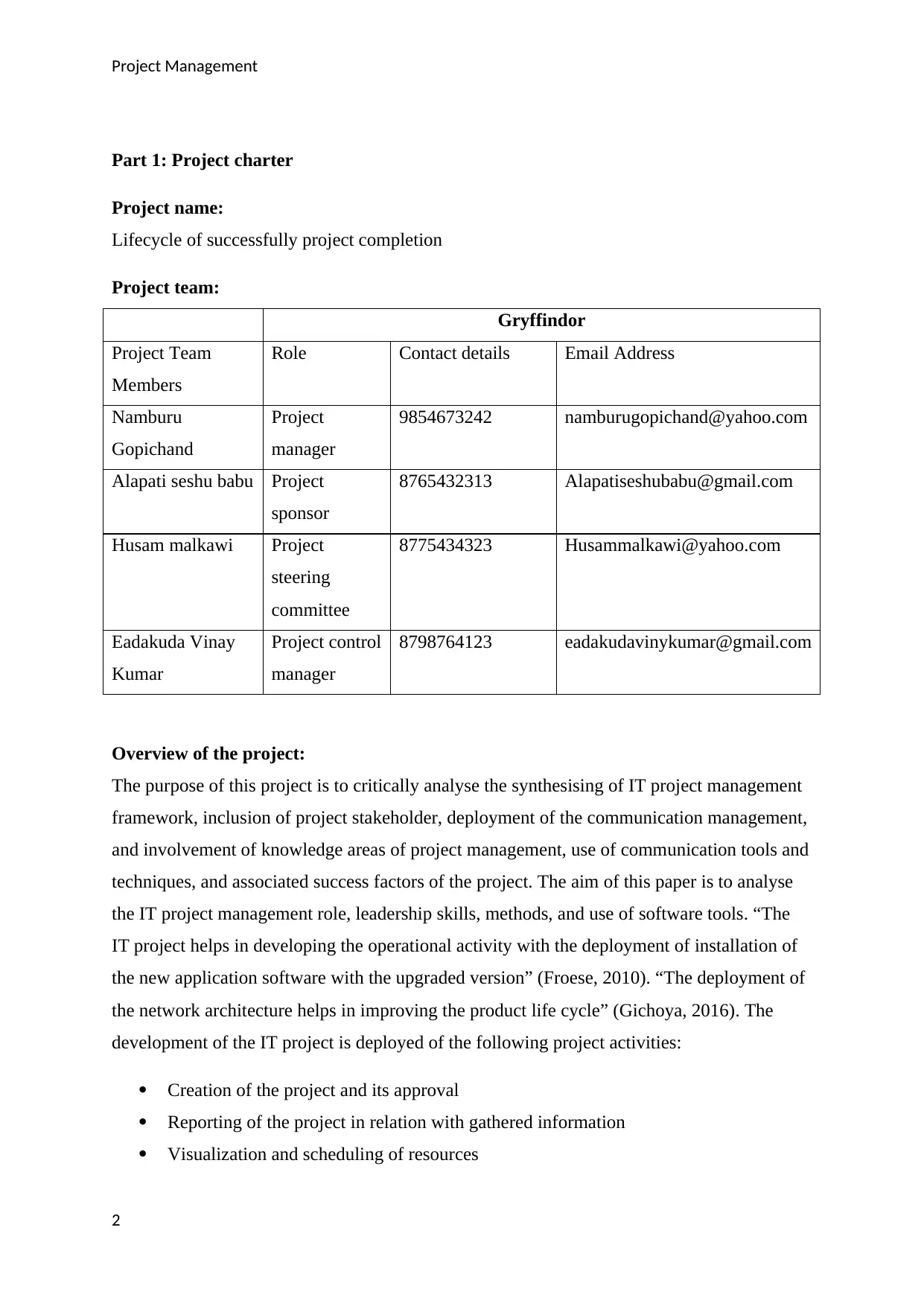
Project Management
Part 1: Project charter
Project name:
Lifecycle of successfully project completion
Project team:
Gryffindor
Project Team
Members
Role Contact details Email Address
Namburu
Gopichand
Project
manager
9854673242 namburugopichand@yahoo.com
Alapati seshu babu Project
sponsor
8765432313 Alapatiseshubabu@gmail.com
Husam malkawi Project
steering
committee
8775434323 Husammalkawi@yahoo.com
Eadakuda Vinay
Kumar
Project control
manager
8798764123 eadakudavinykumar@gmail.com
Overview of the project:
The purpose of this project is to critically analyse the synthesising of IT project management
framework, inclusion of project stakeholder, deployment of the communication management,
and involvement of knowledge areas of project management, use of communication tools and
techniques, and associated success factors of the project. The aim of this paper is to analyse
the IT project management role, leadership skills, methods, and use of software tools. “The
IT project helps in developing the operational activity with the deployment of installation of
the new application software with the upgraded version” (Froese, 2010). “The deployment of
the network architecture helps in improving the product life cycle” (Gichoya, 2016). The
development of the IT project is deployed of the following project activities:
Creation of the project and its approval
Reporting of the project in relation with gathered information
Visualization and scheduling of resources
2
Part 1: Project charter
Project name:
Lifecycle of successfully project completion
Project team:
Gryffindor
Project Team
Members
Role Contact details Email Address
Namburu
Gopichand
Project
manager
9854673242 namburugopichand@yahoo.com
Alapati seshu babu Project
sponsor
8765432313 Alapatiseshubabu@gmail.com
Husam malkawi Project
steering
committee
8775434323 Husammalkawi@yahoo.com
Eadakuda Vinay
Kumar
Project control
manager
8798764123 eadakudavinykumar@gmail.com
Overview of the project:
The purpose of this project is to critically analyse the synthesising of IT project management
framework, inclusion of project stakeholder, deployment of the communication management,
and involvement of knowledge areas of project management, use of communication tools and
techniques, and associated success factors of the project. The aim of this paper is to analyse
the IT project management role, leadership skills, methods, and use of software tools. “The
IT project helps in developing the operational activity with the deployment of installation of
the new application software with the upgraded version” (Froese, 2010). “The deployment of
the network architecture helps in improving the product life cycle” (Gichoya, 2016). The
development of the IT project is deployed of the following project activities:
Creation of the project and its approval
Reporting of the project in relation with gathered information
Visualization and scheduling of resources
2
⊘ This is a preview!⊘
Do you want full access?
Subscribe today to unlock all pages.

Trusted by 1+ million students worldwide
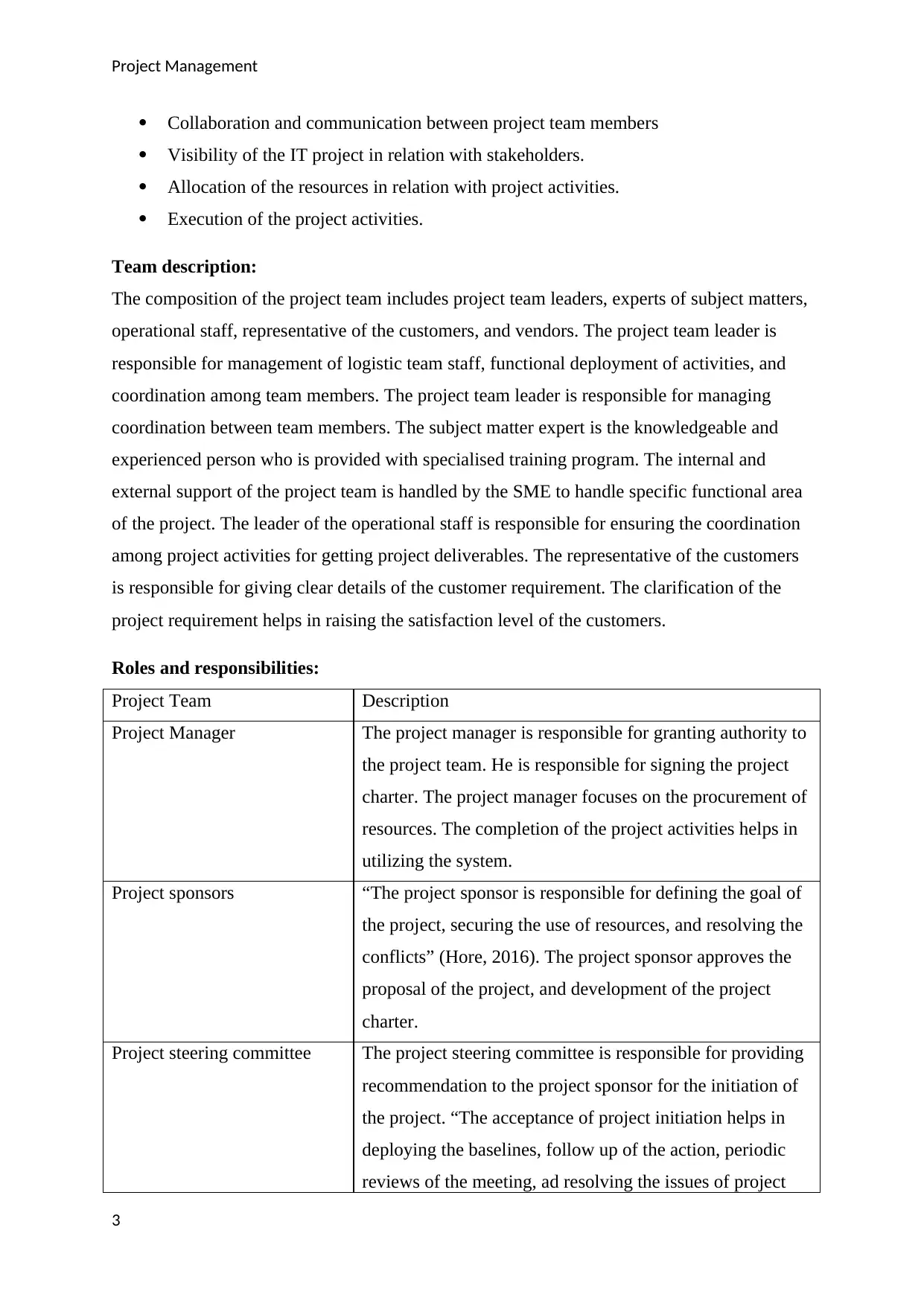
Project Management
Collaboration and communication between project team members
Visibility of the IT project in relation with stakeholders.
Allocation of the resources in relation with project activities.
Execution of the project activities.
Team description:
The composition of the project team includes project team leaders, experts of subject matters,
operational staff, representative of the customers, and vendors. The project team leader is
responsible for management of logistic team staff, functional deployment of activities, and
coordination among team members. The project team leader is responsible for managing
coordination between team members. The subject matter expert is the knowledgeable and
experienced person who is provided with specialised training program. The internal and
external support of the project team is handled by the SME to handle specific functional area
of the project. The leader of the operational staff is responsible for ensuring the coordination
among project activities for getting project deliverables. The representative of the customers
is responsible for giving clear details of the customer requirement. The clarification of the
project requirement helps in raising the satisfaction level of the customers.
Roles and responsibilities:
Project Team Description
Project Manager The project manager is responsible for granting authority to
the project team. He is responsible for signing the project
charter. The project manager focuses on the procurement of
resources. The completion of the project activities helps in
utilizing the system.
Project sponsors “The project sponsor is responsible for defining the goal of
the project, securing the use of resources, and resolving the
conflicts” (Hore, 2016). The project sponsor approves the
proposal of the project, and development of the project
charter.
Project steering committee The project steering committee is responsible for providing
recommendation to the project sponsor for the initiation of
the project. “The acceptance of project initiation helps in
deploying the baselines, follow up of the action, periodic
reviews of the meeting, ad resolving the issues of project
3
Collaboration and communication between project team members
Visibility of the IT project in relation with stakeholders.
Allocation of the resources in relation with project activities.
Execution of the project activities.
Team description:
The composition of the project team includes project team leaders, experts of subject matters,
operational staff, representative of the customers, and vendors. The project team leader is
responsible for management of logistic team staff, functional deployment of activities, and
coordination among team members. The project team leader is responsible for managing
coordination between team members. The subject matter expert is the knowledgeable and
experienced person who is provided with specialised training program. The internal and
external support of the project team is handled by the SME to handle specific functional area
of the project. The leader of the operational staff is responsible for ensuring the coordination
among project activities for getting project deliverables. The representative of the customers
is responsible for giving clear details of the customer requirement. The clarification of the
project requirement helps in raising the satisfaction level of the customers.
Roles and responsibilities:
Project Team Description
Project Manager The project manager is responsible for granting authority to
the project team. He is responsible for signing the project
charter. The project manager focuses on the procurement of
resources. The completion of the project activities helps in
utilizing the system.
Project sponsors “The project sponsor is responsible for defining the goal of
the project, securing the use of resources, and resolving the
conflicts” (Hore, 2016). The project sponsor approves the
proposal of the project, and development of the project
charter.
Project steering committee The project steering committee is responsible for providing
recommendation to the project sponsor for the initiation of
the project. “The acceptance of project initiation helps in
deploying the baselines, follow up of the action, periodic
reviews of the meeting, ad resolving the issues of project
3
Paraphrase This Document
Need a fresh take? Get an instant paraphrase of this document with our AI Paraphraser
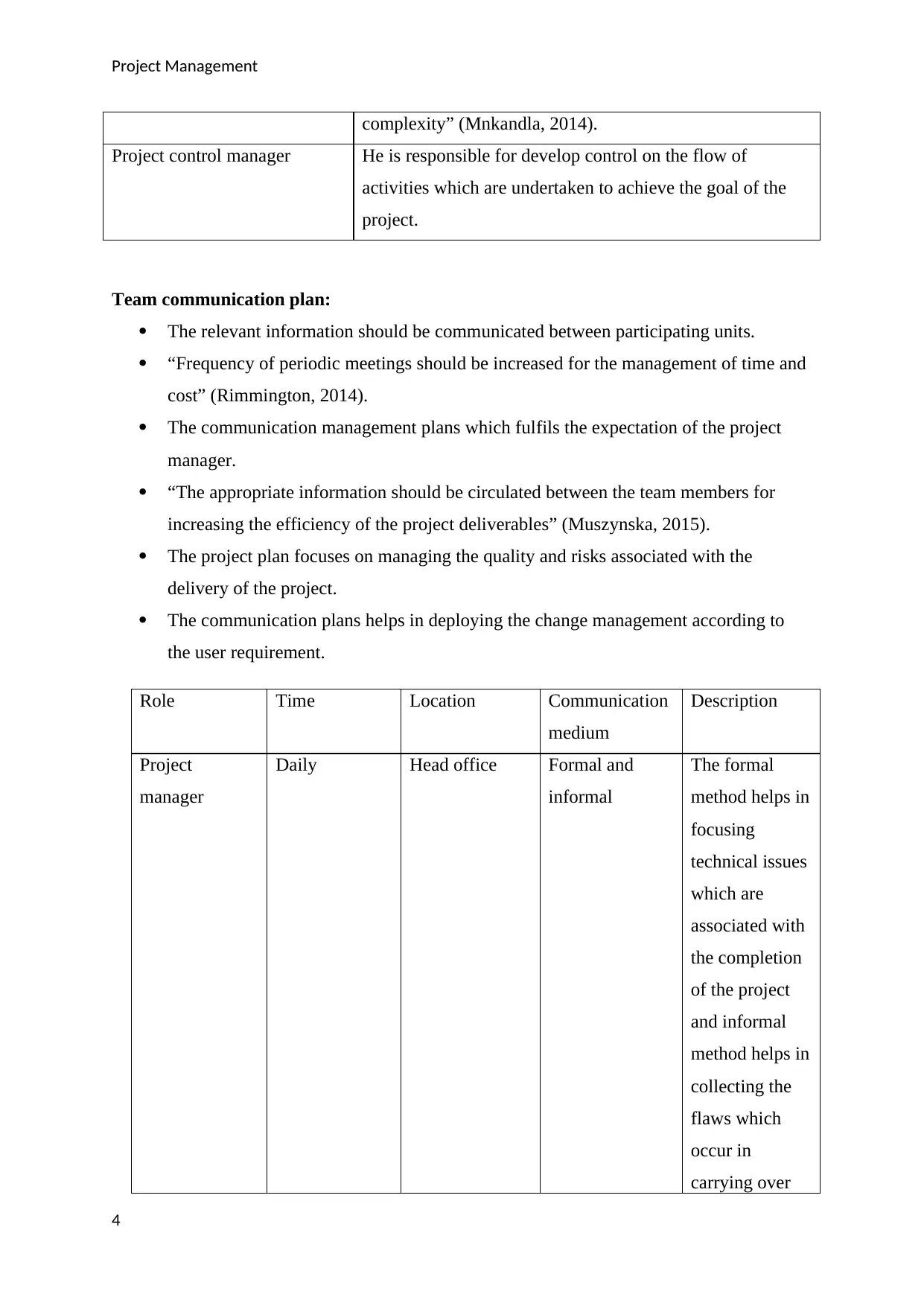
Project Management
complexity” (Mnkandla, 2014).
Project control manager He is responsible for develop control on the flow of
activities which are undertaken to achieve the goal of the
project.
Team communication plan:
The relevant information should be communicated between participating units.
“Frequency of periodic meetings should be increased for the management of time and
cost” (Rimmington, 2014).
The communication management plans which fulfils the expectation of the project
manager.
“The appropriate information should be circulated between the team members for
increasing the efficiency of the project deliverables” (Muszynska, 2015).
The project plan focuses on managing the quality and risks associated with the
delivery of the project.
The communication plans helps in deploying the change management according to
the user requirement.
Role Time Location Communication
medium
Description
Project
manager
Daily Head office Formal and
informal
The formal
method helps in
focusing
technical issues
which are
associated with
the completion
of the project
and informal
method helps in
collecting the
flaws which
occur in
carrying over
4
complexity” (Mnkandla, 2014).
Project control manager He is responsible for develop control on the flow of
activities which are undertaken to achieve the goal of the
project.
Team communication plan:
The relevant information should be communicated between participating units.
“Frequency of periodic meetings should be increased for the management of time and
cost” (Rimmington, 2014).
The communication management plans which fulfils the expectation of the project
manager.
“The appropriate information should be circulated between the team members for
increasing the efficiency of the project deliverables” (Muszynska, 2015).
The project plan focuses on managing the quality and risks associated with the
delivery of the project.
The communication plans helps in deploying the change management according to
the user requirement.
Role Time Location Communication
medium
Description
Project
manager
Daily Head office Formal and
informal
The formal
method helps in
focusing
technical issues
which are
associated with
the completion
of the project
and informal
method helps in
collecting the
flaws which
occur in
carrying over
4
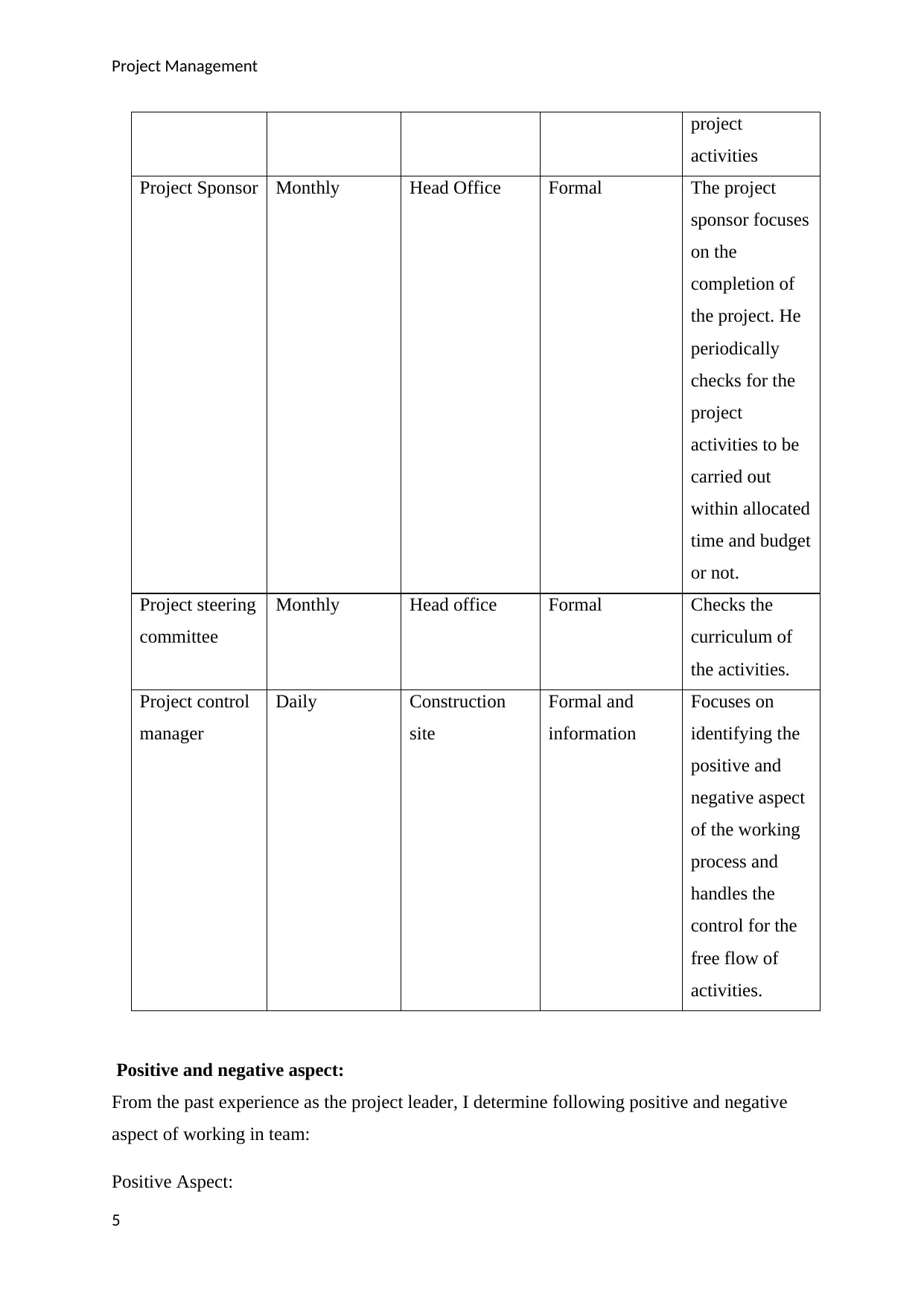
Project Management
project
activities
Project Sponsor Monthly Head Office Formal The project
sponsor focuses
on the
completion of
the project. He
periodically
checks for the
project
activities to be
carried out
within allocated
time and budget
or not.
Project steering
committee
Monthly Head office Formal Checks the
curriculum of
the activities.
Project control
manager
Daily Construction
site
Formal and
information
Focuses on
identifying the
positive and
negative aspect
of the working
process and
handles the
control for the
free flow of
activities.
Positive and negative aspect:
From the past experience as the project leader, I determine following positive and negative
aspect of working in team:
Positive Aspect:
5
project
activities
Project Sponsor Monthly Head Office Formal The project
sponsor focuses
on the
completion of
the project. He
periodically
checks for the
project
activities to be
carried out
within allocated
time and budget
or not.
Project steering
committee
Monthly Head office Formal Checks the
curriculum of
the activities.
Project control
manager
Daily Construction
site
Formal and
information
Focuses on
identifying the
positive and
negative aspect
of the working
process and
handles the
control for the
free flow of
activities.
Positive and negative aspect:
From the past experience as the project leader, I determine following positive and negative
aspect of working in team:
Positive Aspect:
5
⊘ This is a preview!⊘
Do you want full access?
Subscribe today to unlock all pages.

Trusted by 1+ million students worldwide
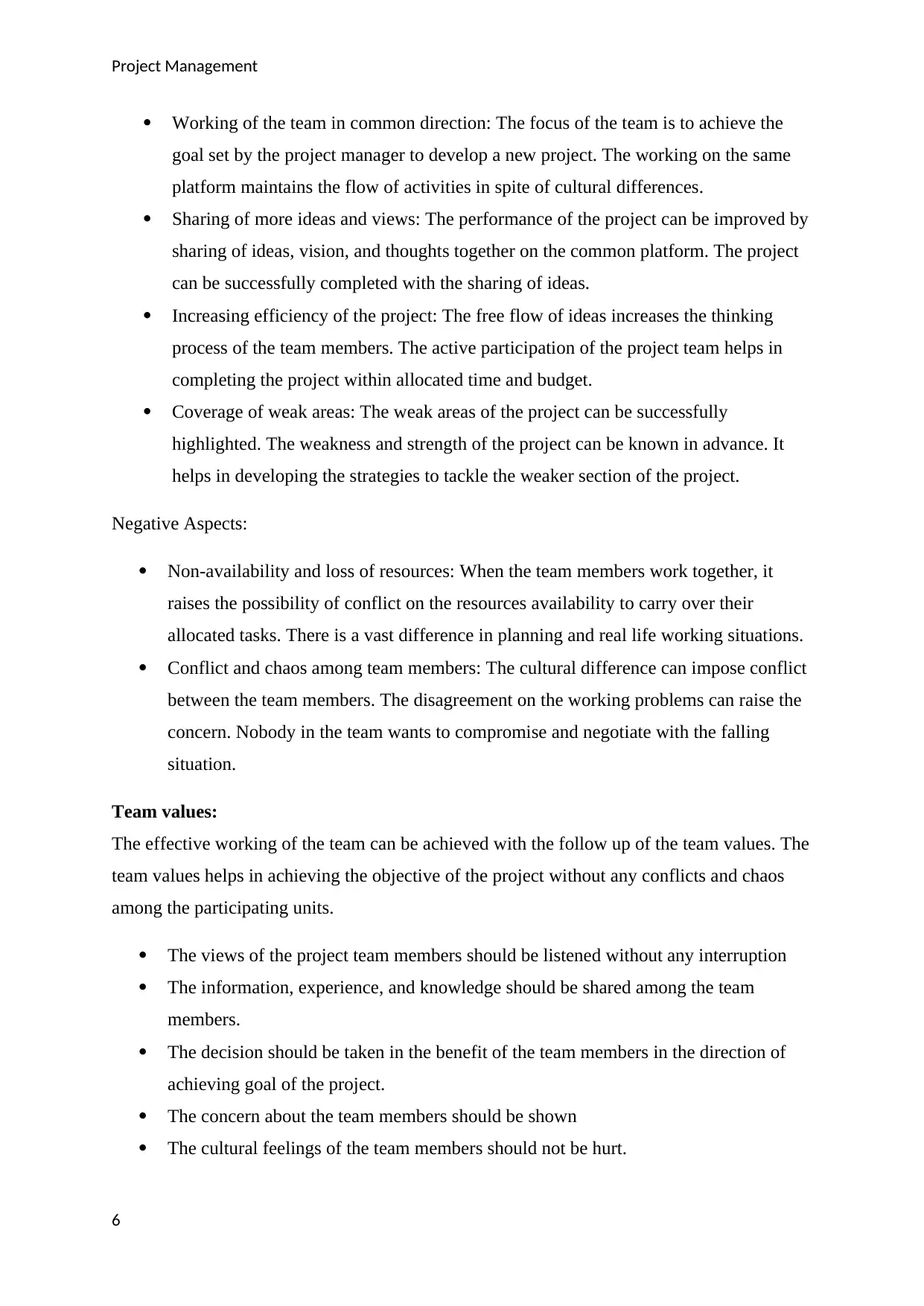
Project Management
Working of the team in common direction: The focus of the team is to achieve the
goal set by the project manager to develop a new project. The working on the same
platform maintains the flow of activities in spite of cultural differences.
Sharing of more ideas and views: The performance of the project can be improved by
sharing of ideas, vision, and thoughts together on the common platform. The project
can be successfully completed with the sharing of ideas.
Increasing efficiency of the project: The free flow of ideas increases the thinking
process of the team members. The active participation of the project team helps in
completing the project within allocated time and budget.
Coverage of weak areas: The weak areas of the project can be successfully
highlighted. The weakness and strength of the project can be known in advance. It
helps in developing the strategies to tackle the weaker section of the project.
Negative Aspects:
Non-availability and loss of resources: When the team members work together, it
raises the possibility of conflict on the resources availability to carry over their
allocated tasks. There is a vast difference in planning and real life working situations.
Conflict and chaos among team members: The cultural difference can impose conflict
between the team members. The disagreement on the working problems can raise the
concern. Nobody in the team wants to compromise and negotiate with the falling
situation.
Team values:
The effective working of the team can be achieved with the follow up of the team values. The
team values helps in achieving the objective of the project without any conflicts and chaos
among the participating units.
The views of the project team members should be listened without any interruption
The information, experience, and knowledge should be shared among the team
members.
The decision should be taken in the benefit of the team members in the direction of
achieving goal of the project.
The concern about the team members should be shown
The cultural feelings of the team members should not be hurt.
6
Working of the team in common direction: The focus of the team is to achieve the
goal set by the project manager to develop a new project. The working on the same
platform maintains the flow of activities in spite of cultural differences.
Sharing of more ideas and views: The performance of the project can be improved by
sharing of ideas, vision, and thoughts together on the common platform. The project
can be successfully completed with the sharing of ideas.
Increasing efficiency of the project: The free flow of ideas increases the thinking
process of the team members. The active participation of the project team helps in
completing the project within allocated time and budget.
Coverage of weak areas: The weak areas of the project can be successfully
highlighted. The weakness and strength of the project can be known in advance. It
helps in developing the strategies to tackle the weaker section of the project.
Negative Aspects:
Non-availability and loss of resources: When the team members work together, it
raises the possibility of conflict on the resources availability to carry over their
allocated tasks. There is a vast difference in planning and real life working situations.
Conflict and chaos among team members: The cultural difference can impose conflict
between the team members. The disagreement on the working problems can raise the
concern. Nobody in the team wants to compromise and negotiate with the falling
situation.
Team values:
The effective working of the team can be achieved with the follow up of the team values. The
team values helps in achieving the objective of the project without any conflicts and chaos
among the participating units.
The views of the project team members should be listened without any interruption
The information, experience, and knowledge should be shared among the team
members.
The decision should be taken in the benefit of the team members in the direction of
achieving goal of the project.
The concern about the team members should be shown
The cultural feelings of the team members should not be hurt.
6
Paraphrase This Document
Need a fresh take? Get an instant paraphrase of this document with our AI Paraphraser

Project Management
The reward and award should be given on the basis of their performance which helps
in motivation and shaping their skills.
Behavioural management of integrity
Continuous improvement in the project activities undertaken
Integrity and accuracy should be maintained in the flow of activities
The dishonesty in the team members should not be undertaken
The Ego and no other cultural difference should be given preference while working in
the team.
Code of ethics:
The privilege should be given to the follow up of the code of ethics in the working
environment. The ethics plays a major role in managing sustainability of the project. The
ethical program focuses on the moral course of action which should be undertaken to resolve
the chaotic issues associated with the team members. The productivity of the project can be
increased with the development of strong team work. The growth of the working employees
can be improved with the use of ethical program within the working curriculum of the
organization.
Rules and expectation:
The follow up of the rules helps in completing the project within allocated time and budget
with the occurrence of the minimum chaos at work place. The following is the set of rules
which should be undertaken to build effective team management:
The meeting should be regularly attended by the team members
The vacation should be told in advance to the project manager
The team members should have to complete their assigned tasks within the mentioned
deadline
The proactive action should be taken by all team members to overcome the problem
of chaos and conflicts
Workload should be equally distributed among the team members according to their
capability.
Signature:
All the participating units should sign off the project charter for approval of the project.
7
The reward and award should be given on the basis of their performance which helps
in motivation and shaping their skills.
Behavioural management of integrity
Continuous improvement in the project activities undertaken
Integrity and accuracy should be maintained in the flow of activities
The dishonesty in the team members should not be undertaken
The Ego and no other cultural difference should be given preference while working in
the team.
Code of ethics:
The privilege should be given to the follow up of the code of ethics in the working
environment. The ethics plays a major role in managing sustainability of the project. The
ethical program focuses on the moral course of action which should be undertaken to resolve
the chaotic issues associated with the team members. The productivity of the project can be
increased with the development of strong team work. The growth of the working employees
can be improved with the use of ethical program within the working curriculum of the
organization.
Rules and expectation:
The follow up of the rules helps in completing the project within allocated time and budget
with the occurrence of the minimum chaos at work place. The following is the set of rules
which should be undertaken to build effective team management:
The meeting should be regularly attended by the team members
The vacation should be told in advance to the project manager
The team members should have to complete their assigned tasks within the mentioned
deadline
The proactive action should be taken by all team members to overcome the problem
of chaos and conflicts
Workload should be equally distributed among the team members according to their
capability.
Signature:
All the participating units should sign off the project charter for approval of the project.
7
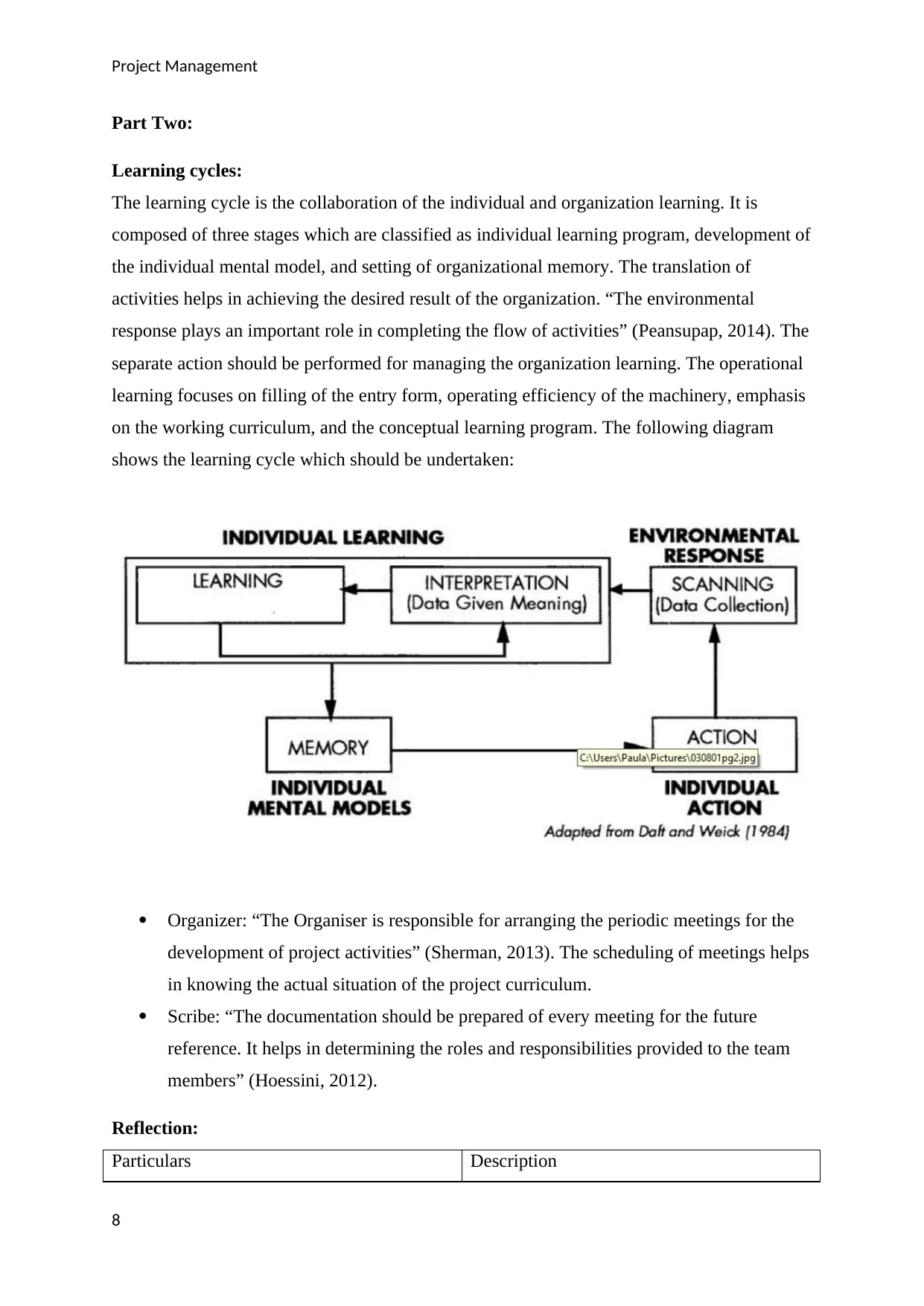
Project Management
Part Two:
Learning cycles:
The learning cycle is the collaboration of the individual and organization learning. It is
composed of three stages which are classified as individual learning program, development of
the individual mental model, and setting of organizational memory. The translation of
activities helps in achieving the desired result of the organization. “The environmental
response plays an important role in completing the flow of activities” (Peansupap, 2014). The
separate action should be performed for managing the organization learning. The operational
learning focuses on filling of the entry form, operating efficiency of the machinery, emphasis
on the working curriculum, and the conceptual learning program. The following diagram
shows the learning cycle which should be undertaken:
Organizer: “The Organiser is responsible for arranging the periodic meetings for the
development of project activities” (Sherman, 2013). The scheduling of meetings helps
in knowing the actual situation of the project curriculum.
Scribe: “The documentation should be prepared of every meeting for the future
reference. It helps in determining the roles and responsibilities provided to the team
members” (Hoessini, 2012).
Reflection:
Particulars Description
8
Part Two:
Learning cycles:
The learning cycle is the collaboration of the individual and organization learning. It is
composed of three stages which are classified as individual learning program, development of
the individual mental model, and setting of organizational memory. The translation of
activities helps in achieving the desired result of the organization. “The environmental
response plays an important role in completing the flow of activities” (Peansupap, 2014). The
separate action should be performed for managing the organization learning. The operational
learning focuses on filling of the entry form, operating efficiency of the machinery, emphasis
on the working curriculum, and the conceptual learning program. The following diagram
shows the learning cycle which should be undertaken:
Organizer: “The Organiser is responsible for arranging the periodic meetings for the
development of project activities” (Sherman, 2013). The scheduling of meetings helps
in knowing the actual situation of the project curriculum.
Scribe: “The documentation should be prepared of every meeting for the future
reference. It helps in determining the roles and responsibilities provided to the team
members” (Hoessini, 2012).
Reflection:
Particulars Description
8
⊘ This is a preview!⊘
Do you want full access?
Subscribe today to unlock all pages.

Trusted by 1+ million students worldwide
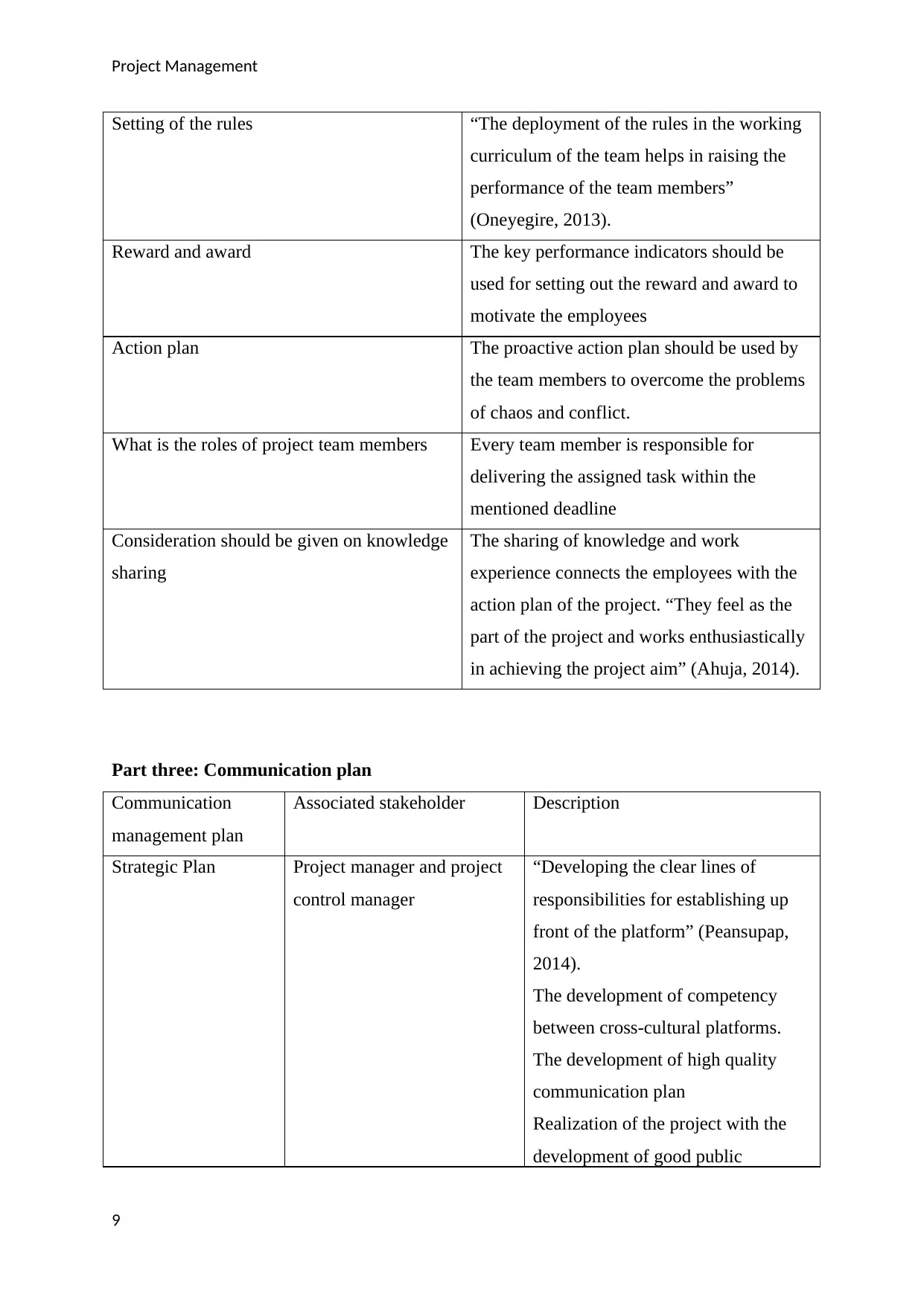
Project Management
Setting of the rules “The deployment of the rules in the working
curriculum of the team helps in raising the
performance of the team members”
(Oneyegire, 2013).
Reward and award The key performance indicators should be
used for setting out the reward and award to
motivate the employees
Action plan The proactive action plan should be used by
the team members to overcome the problems
of chaos and conflict.
What is the roles of project team members Every team member is responsible for
delivering the assigned task within the
mentioned deadline
Consideration should be given on knowledge
sharing
The sharing of knowledge and work
experience connects the employees with the
action plan of the project. “They feel as the
part of the project and works enthusiastically
in achieving the project aim” (Ahuja, 2014).
Part three: Communication plan
Communication
management plan
Associated stakeholder Description
Strategic Plan Project manager and project
control manager
“Developing the clear lines of
responsibilities for establishing up
front of the platform” (Peansupap,
2014).
The development of competency
between cross-cultural platforms.
The development of high quality
communication plan
Realization of the project with the
development of good public
9
Setting of the rules “The deployment of the rules in the working
curriculum of the team helps in raising the
performance of the team members”
(Oneyegire, 2013).
Reward and award The key performance indicators should be
used for setting out the reward and award to
motivate the employees
Action plan The proactive action plan should be used by
the team members to overcome the problems
of chaos and conflict.
What is the roles of project team members Every team member is responsible for
delivering the assigned task within the
mentioned deadline
Consideration should be given on knowledge
sharing
The sharing of knowledge and work
experience connects the employees with the
action plan of the project. “They feel as the
part of the project and works enthusiastically
in achieving the project aim” (Ahuja, 2014).
Part three: Communication plan
Communication
management plan
Associated stakeholder Description
Strategic Plan Project manager and project
control manager
“Developing the clear lines of
responsibilities for establishing up
front of the platform” (Peansupap,
2014).
The development of competency
between cross-cultural platforms.
The development of high quality
communication plan
Realization of the project with the
development of good public
9
Paraphrase This Document
Need a fresh take? Get an instant paraphrase of this document with our AI Paraphraser
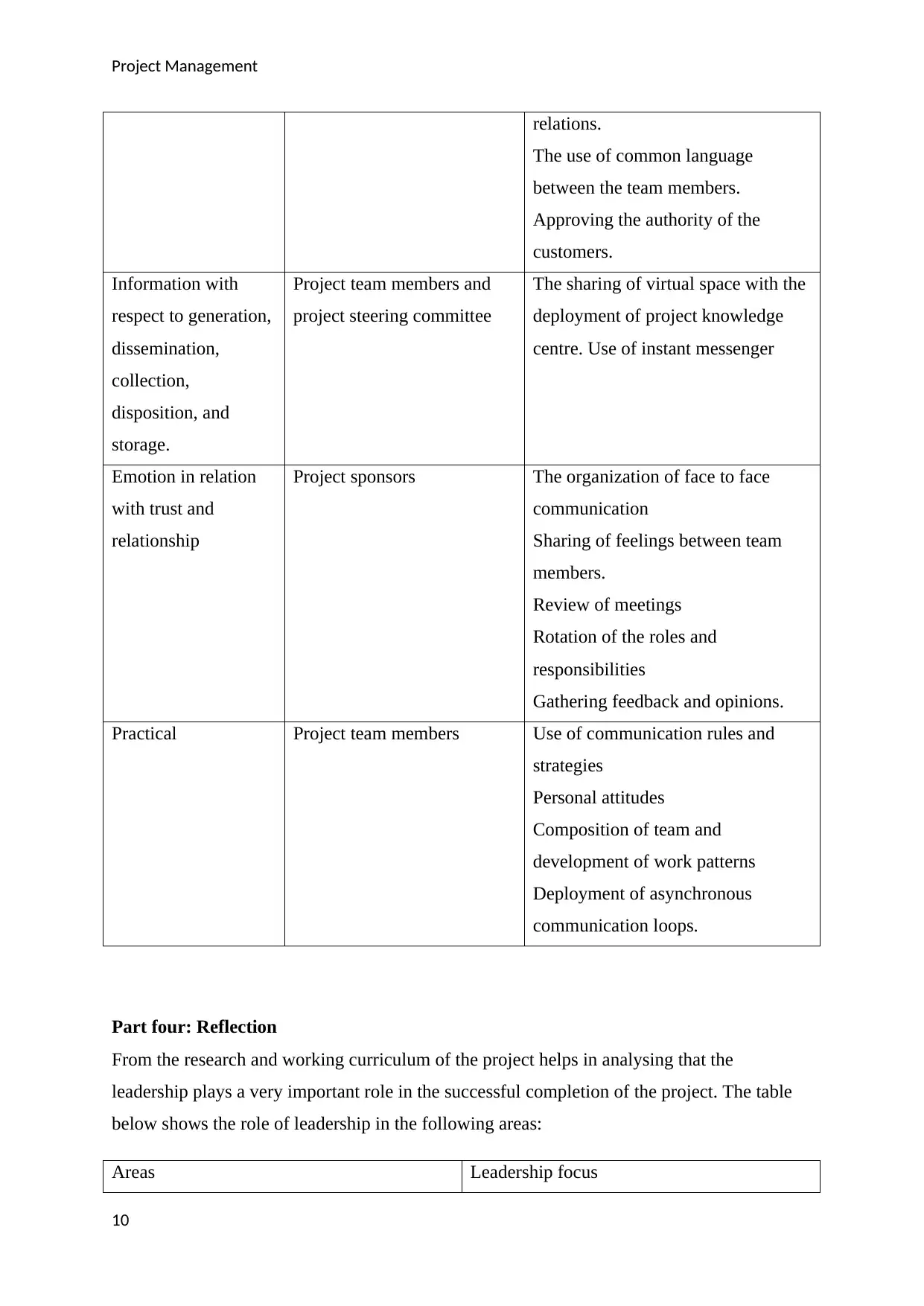
Project Management
relations.
The use of common language
between the team members.
Approving the authority of the
customers.
Information with
respect to generation,
dissemination,
collection,
disposition, and
storage.
Project team members and
project steering committee
The sharing of virtual space with the
deployment of project knowledge
centre. Use of instant messenger
Emotion in relation
with trust and
relationship
Project sponsors The organization of face to face
communication
Sharing of feelings between team
members.
Review of meetings
Rotation of the roles and
responsibilities
Gathering feedback and opinions.
Practical Project team members Use of communication rules and
strategies
Personal attitudes
Composition of team and
development of work patterns
Deployment of asynchronous
communication loops.
Part four: Reflection
From the research and working curriculum of the project helps in analysing that the
leadership plays a very important role in the successful completion of the project. The table
below shows the role of leadership in the following areas:
Areas Leadership focus
10
relations.
The use of common language
between the team members.
Approving the authority of the
customers.
Information with
respect to generation,
dissemination,
collection,
disposition, and
storage.
Project team members and
project steering committee
The sharing of virtual space with the
deployment of project knowledge
centre. Use of instant messenger
Emotion in relation
with trust and
relationship
Project sponsors The organization of face to face
communication
Sharing of feelings between team
members.
Review of meetings
Rotation of the roles and
responsibilities
Gathering feedback and opinions.
Practical Project team members Use of communication rules and
strategies
Personal attitudes
Composition of team and
development of work patterns
Deployment of asynchronous
communication loops.
Part four: Reflection
From the research and working curriculum of the project helps in analysing that the
leadership plays a very important role in the successful completion of the project. The table
below shows the role of leadership in the following areas:
Areas Leadership focus
10
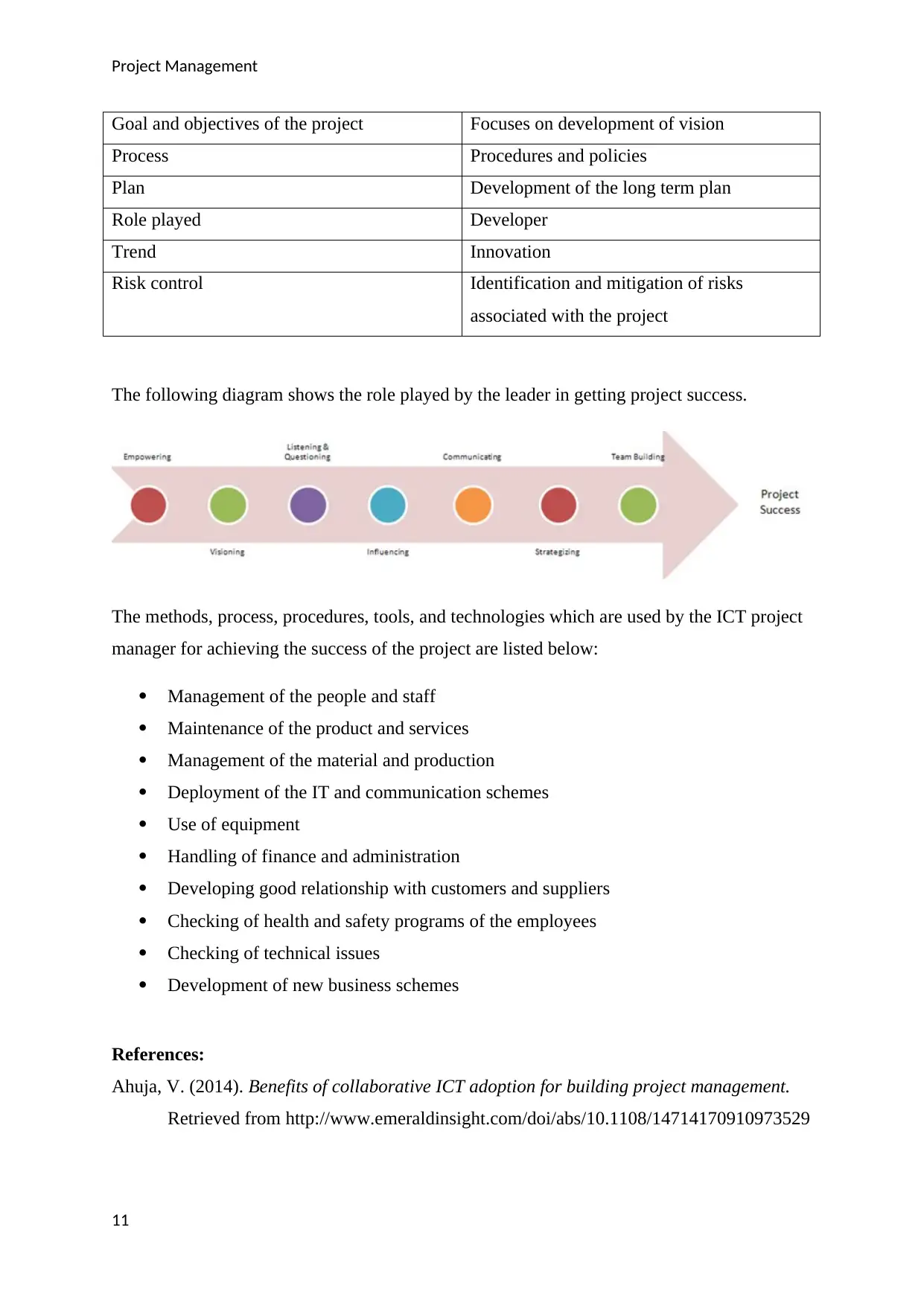
Project Management
Goal and objectives of the project Focuses on development of vision
Process Procedures and policies
Plan Development of the long term plan
Role played Developer
Trend Innovation
Risk control Identification and mitigation of risks
associated with the project
The following diagram shows the role played by the leader in getting project success.
The methods, process, procedures, tools, and technologies which are used by the ICT project
manager for achieving the success of the project are listed below:
Management of the people and staff
Maintenance of the product and services
Management of the material and production
Deployment of the IT and communication schemes
Use of equipment
Handling of finance and administration
Developing good relationship with customers and suppliers
Checking of health and safety programs of the employees
Checking of technical issues
Development of new business schemes
References:
Ahuja, V. (2014). Benefits of collaborative ICT adoption for building project management.
Retrieved from http://www.emeraldinsight.com/doi/abs/10.1108/14714170910973529
11
Goal and objectives of the project Focuses on development of vision
Process Procedures and policies
Plan Development of the long term plan
Role played Developer
Trend Innovation
Risk control Identification and mitigation of risks
associated with the project
The following diagram shows the role played by the leader in getting project success.
The methods, process, procedures, tools, and technologies which are used by the ICT project
manager for achieving the success of the project are listed below:
Management of the people and staff
Maintenance of the product and services
Management of the material and production
Deployment of the IT and communication schemes
Use of equipment
Handling of finance and administration
Developing good relationship with customers and suppliers
Checking of health and safety programs of the employees
Checking of technical issues
Development of new business schemes
References:
Ahuja, V. (2014). Benefits of collaborative ICT adoption for building project management.
Retrieved from http://www.emeraldinsight.com/doi/abs/10.1108/14714170910973529
11
⊘ This is a preview!⊘
Do you want full access?
Subscribe today to unlock all pages.

Trusted by 1+ million students worldwide
1 out of 14
Related Documents
Your All-in-One AI-Powered Toolkit for Academic Success.
+13062052269
info@desklib.com
Available 24*7 on WhatsApp / Email
![[object Object]](/_next/static/media/star-bottom.7253800d.svg)
Unlock your academic potential
Copyright © 2020–2025 A2Z Services. All Rights Reserved. Developed and managed by ZUCOL.





